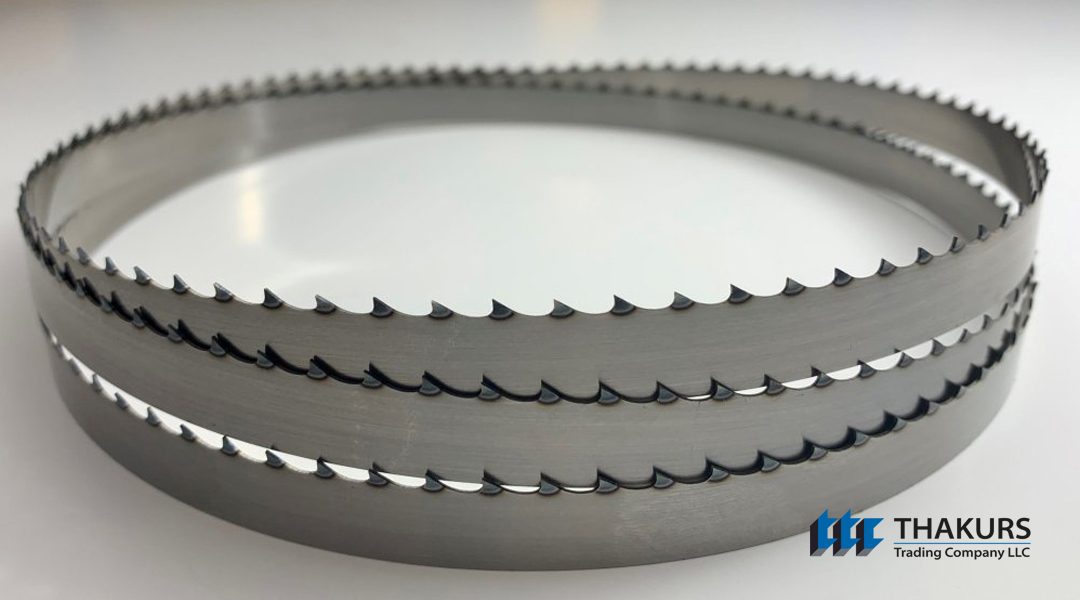
Bandsaw blades come in a variety of widths, thicknesses, and tooth configurations, each of which is designed for specific types of cutting applications. The most common types of bandsaw blades include:
- Regular Tooth: This type of blade has teeth that are evenly spaced and set at a 0-degree rake angle. It is suitable for general-purpose cutting of materials such as wood, plastics, and non-ferrous metals.
- Skip Tooth: This blade has widely spaced teeth that are set at a 0-degree rake angle. It is suitable for cutting thicker materials, such as hardwoods, metals, and plastics.
- Hook Tooth: This blade has teeth that are set at a positive rake angle, which makes them more aggressive than regular or skip tooth blades. It is suitable for cutting softer materials, such as softwoods and plastics.
- Bi-Metal Blade: This blade has a high-speed steel cutting edge welded onto a high-carbon steel blade. It is suitable for cutting harder materials, such as ferrous metals and alloys.
Width:
- 1/8″ to 1″ (smaller blades are typically used for detailed cuts and curves, while larger blades are used for straight cuts and resawing)
Thickness:
- 014″ to 0.063″ (thicker blades are typically used for larger and tougher materials, while thinner blades are used for smaller and more delicate cuts)
Length:
- Bandsaw blade lengths can vary widely depending on the size and make of the bandsaw machine. Common lengths range from 56″ to 200″ for benchtop and small floor-standing bandsaws, while larger industrial bandsaws can accommodate blades up to 600″ or longer.
Note that the specific size of bandsaw blades may vary depending on the manufacturer and intended use, and it is important to select the right blade size for the material being cut and the type of cut being made. Additionally, it is important to properly tension the blade and to maintain it to ensure optimal performance and longevity.
Here is a teeth chart for bandsaw blades:
- Regular Tooth (also known as Standard Tooth):
- Teeth are evenly spaced and set at a 0-degree rake angle.
- Suitable for general-purpose cutting of materials such as wood, plastics, and non-ferrous metals.
- Best for materials up to 3/4″ thick.
- Skip Tooth:
- Teeth are widely spaced and set at a 0-degree rake angle.
- Suitable for cutting thicker materials, such as hardwoods, metals, and plastics.
- Best for materials 1″ or thicker.
- Hook Tooth:
- Teeth are set at a positive rake angle, making them more aggressive than regular or skip tooth blades.
- Suitable for cutting softer materials, such as softwoods and plastics.
- Best for materials up to 1/2″ thick.
- Variable Tooth:
- Teeth are a combination of different tooth styles and spacings, allowing for more versatility in cutting different materials.
- Suitable for cutting a variety of materials, including wood, metal, and plastics.
- Best for materials up to 3/4″ thick.
- Bi-Metal Blade:
- Teeth are made of high-speed steel and welded onto a high-carbon steel blade.
- Suitable for cutting harder materials, such as ferrous metals and alloys.
- Best for materials up to 1/2″ thick.
Note that the specific teeth configuration of bandsaw blades may vary depending on the manufacturer and intended use, and it is important to select the right teeth configuration for the material being cut and the type of cut being made. Additionally, it is important to properly tension the blade and to maintain it to ensure optimal performance and longevity.
